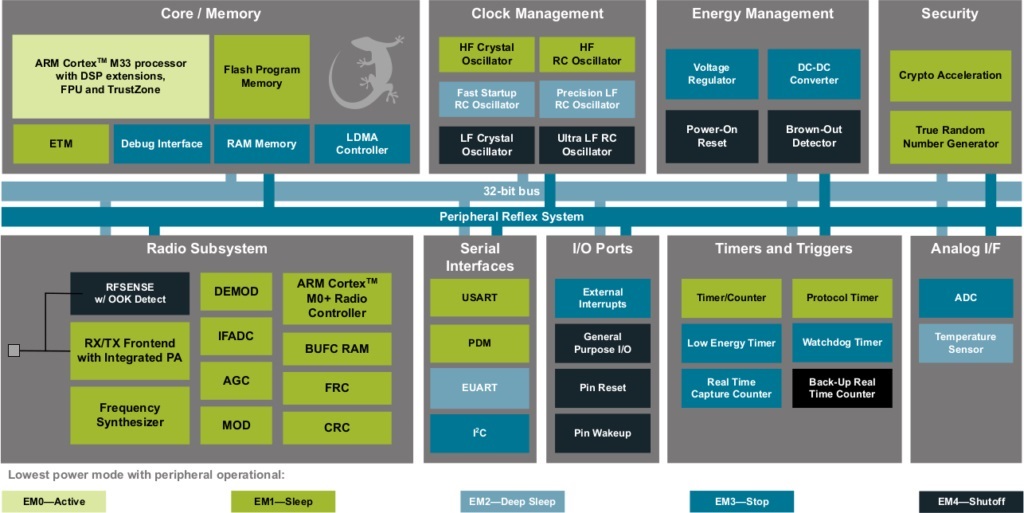Bluetooth 5.2 SoC Brings Longevity to IoT Batteries
Article By : M. Di Paolo Emilio

The new SoC supports the new Bluetooth 5.2 standard, Bluetooth mesh, and direction finding with sub-meter accuracy.
Silicon Labs presented at CES a new system-on-chip (SoC) EFR32BG22 (BG22) that offers hardware and software stack combinations to meet market demand for battery-powered high-volume IoT products.
IoT is a reality present and used in the “consumer” world, with the adoption by consumers of many products/services already widespread from wearable items to “smart” appliances and upcoming transports, connected vehicles, and autonomous/assisted driving.
The advent of the IoT is steering the future of electronics toward a world where physical objects will all be connected and wireless communication will offer higher levels of freedom and flexibility. There is a growing demand for ultra-low-power wireless connectivity from consumers seeking to extend their wireless experience to compact electronic devices with small batteries. Bluetooth Low Energy (BLE) technology brings low-cost wireless connectivity to small, long-lasting devices. It was designed from the ground up to meet the need for energy efficiency and design simplicity.
Market analysts at the Bluetooth SIG predict that shipments of Bluetooth devices will grow by 26% by 2023 and that 90% of all Bluetooth devices will include Bluetooth Low Energy by 2023. The key requirements of the market are secure connectivity, i.e., that the devices work with only genuine and reliable firmware and extremely low power consumption.
Recommended
Silicon Labs’ CEO on IoT, UWB and AI
Energy consumption in BLE SoCs is generally due to the processor and radio module. The processor can absorb several milliamps during operation. Some BLE radios may peak at 20 mA during transmission. Which part consumes more depends primarily on the application and duty cycle. Most BLE products are designed to sleep as much as possible to save energy, wake up to process, and send data.
With a high-performance, low-power Arm Cortex-M33 core (27 µA/MHz active, 1.2 µA sleep), the new SoC supports the new Bluetooth 5.2 standard, Bluetooth mesh, and direction finding with sub-meter accuracy. The SoC EFR32BG22C112 addresses high-volume and cost-sensitive applications. It has an operating temperature of up to 125°C and extends flash memory up to 512 kB. Target applications include low-power Bluetooth mesh network nodes, smart port locks, and personal health and fitness devices (Figure 1).

Silicon Labs BG22 Secure Bluetooth 5.2 SoC block diagram
“From fitness trackers and health and wellness sensors to smartphone accessories and PC peripherals, low-power data transfer represents one of the biggest and fastest-growing application opportunities for Bluetooth Low Energy connectivity,” said Mikko Savolainen, senior marketing manager at Silicon Labs. “Silicon Labs’s EFR32BG22 Bluetooth 5.2 SoCs, announced this week at CES 2020, are ideal for these Bluetooth LE applications, as they require extremely low power consumption to maximize battery life, as well as compact size and the right price points for mass-market IoT products. The new BG22 SoCs provide an optimal combination of energy efficiency, wireless performance, security and software tools, and stacks to meet the market demand for high-volume, battery-powered IoT products.
“In addition to supporting Bluetooth LE data transfer, the SoCs are a great option for Bluetooth mesh low-power nodes and for direction-finding and asset-tracking applications requiring sub-1-meter accuracy. Bluetooth remains the protocol of choice for creating proximity solutions used for point-of-interest information, item finding, and real-time asset-tracking (RTLS) solutions and indoor positioning systems (IPS). BG22 SoCs support Bluetooth 5.1/5.2 direction-finding features, including Angle of Arrival [AoA] and Angle of Departure [AoD], and can be used to build some of the smallest, lowest-power asset tags and beacons as well as RTLS locators.”
Although IoT devices extend the functionality of various machines and components, at the same time, they increase the vulnerabilities of all devices connected to the network. New companies will need to pay attention and move on two fronts, the technological one to capture the potential and the security one to avoid compromising situations.
BG22 SoCs respond to an essential issue of IoT devices: security. The Secure Boot functionality of Silicon Labs with Root of Trust and Secure Loader offers a simple and efficient solution. SoCs support comprehensive fault analysis, allowing developers to investigate problems without erasing the flash. Developers achieve this through the secure debugging of Silicon Labs with lock/unlock encryption capabilities.
Subscribe to Newsletter
Test Qr code text s ss


